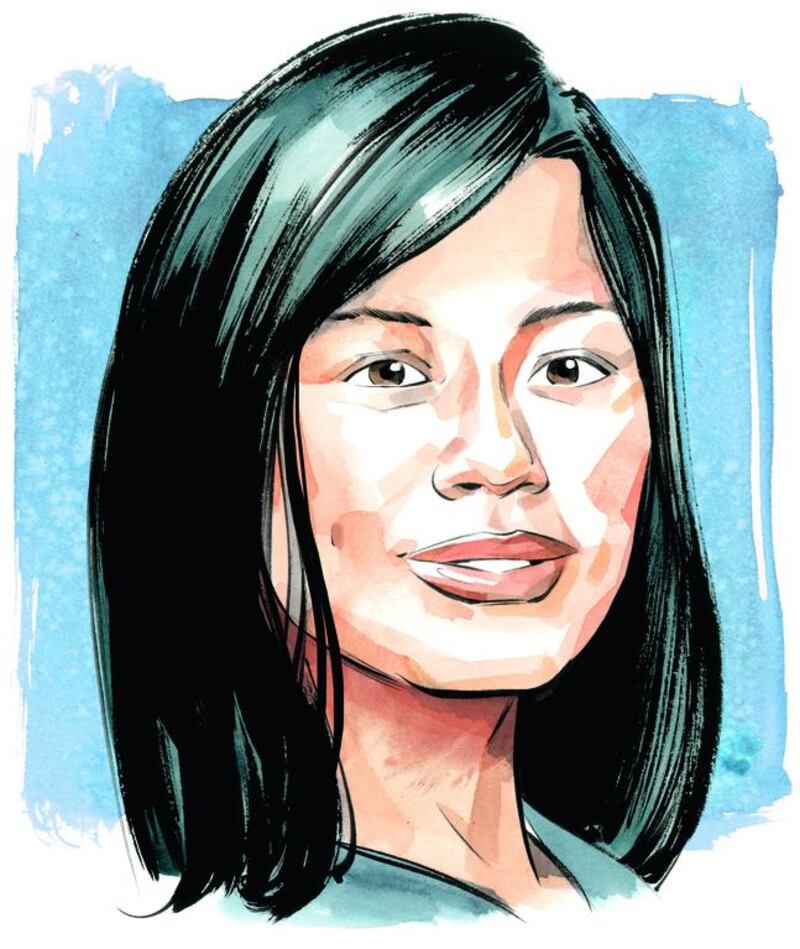It isn’t the first time that the apparently disparate demands of downhill skiing and expert mastery of a stringed classical instrument have been tackled by one person with such flair.
After all, who can forget the scene in the 1987 film The Living Daylights, when Timothy Dalton and the Bond girl Maryam d’Abo slalomed to safety down a snowy mountainside atop her cello case, with 007 wielding the instrument as a ski pole?
Not that the one-time child violin prodigy Vanessa-Mae will be attempting both feats simultaneously when she adds another string to her bow and competes for Thailand in the women’s giant slalom at the Sochi Winter Olympics on Tuesday.
But even if the 35-year-old skier fails to steal a place on the podium – and, up against serious athletes from Austria, Switzerland and the US, she almost certainly will – few could doubt that she deserves a lifetime medal for overachievement.
Vanessa-Mae Vanakorn was born in Singapore in 1978 to a Thai father and a Chinese mother, and it serves as a warning to all pushy parents that, at various stages in her life, she has been estranged from both of them.
According to Vanessa-Mae’s own account, it was her mother, Pamela Soei Luang Tan, a lawyer and something of a frustrated concert pianist, who was the driving force behind the development of her talent.
Her parents split up when Vanessa-Mae was four and, after her mother married a British lawyer working in Singapore, the three of them moved to the UK, which Vanessa-Mae calls home to this day.
She had begun studying the piano and learning to read music when she was just three and had her first lesson on the violin at the age of five. It wasn’t all hard work, though; her parents took her skiing for the first time at the age of four.
Perhaps her mother’s determination that she would succeed was inspired by the fact that her daughter shares a birthday with Niccolò Paganini, the virtuoso 19th-century Italian violinist. Either way, she was determined that her daughter would become a star, an ambition that extended to making her skip school so she could practise violin.
Later, Vanessa-Mae would recall that her mother told her: “I love you because you are my daughter, but you’ll never be special to me unless you play the violin.”
It might not have been ideal parenting, but it did pay off. Vanessa-Mae shot to fame and fortune in her teens, though the success came at a price, as the violinist told a magazine seven years ago.
“During the second half of my teenage years and my early 20s, my life was like a treadmill,” she said. “I wasn’t enjoying it and it became too much.”
Unsurprisingly, her relationship with her mother buckled.
“My mother is, and always has been, an extremely driven person and has an unquenchable thirst for success, and that is something that can be very difficult to understand when you are a child or a teenager,” Vanessa-Mae told a British newspaper in 2008.
Pamela had always acted as her daughter’s manager – until 2000, when Vanessa-Mae sacked her in the hope, she said, that they might have a normal mother-daughter relationship. They never spoke again.
In 2008, her mother was invited to contribute to a BBC documentary examining whether the violinist’s talent was the product of nature or nurture. On camera, a clearly upset Vanessa-Mae read out her mother’s terse reply: “My daughter is nearly 30. That part of my life is well and truly over.”
Vanessa-Mae acknowledged that “I would not be here today without my mother and she has helped me have a career that I love and to follow a vocation”. Nevertheless, she remained “sad that it has been at the expense of my relationship with her”.
Vanessa-Mae’s appearance at the Sochi Winter Olympics as a contestant in the women’s giant slalom has attracted almost as much attention as her first crossover pop album did when it was released in 1995.
A child prodigy who had played her first orchestra concert at the age of 10, there was no doubting Vanessa-Mae’s talent.
But purists were aghast at The Violin Player, the product of Vanessa-Mae’s collaboration with the pop producer Mike Batt, better known as the musical force behind the children’s TV favourite The Wombles.
In addition to seven tracks composed by Batt, the album opened with a pop version of Bach’s Toccata and Fugue in D Minor, which as a single sold millions of copies and gave Vanessa-Mae her first chart success. The album spent 21 weeks in the charts.
But for the classical music establishment, the album was seen not only as a shockingly trite betrayal of Vanessa-Mae’s obvious talent, but also as the cynical exploitation of a young woman’s sexuality in the pursuit of record sales.
On her first album, Violin, released in 1991 when she was 12 years old, Vanessa-Mae had brilliantly performed pieces by Sarasate, Kabalevsky and Mozart, in an acclaimed recording made with the world-renowned Mozart Players.
That same year, she also issued an album of Kids’ Classics, followed by the impressively heavyweight recording Tchaikovsky and Beethoven Violin Concertos, recorded with the London Symphony Orchestra.
Four years were to pass before Vanessa-Mae hit the charts – and the headlines – again. It was, perhaps, that long pause that triggered the artist’s embrace of what EMI, her new record company, called “violin techno-acoustic fusion”. She swapped Gizmo, her 18th-century Guadagnini violin, for a modern, electric Zeta Jazz model – and adopted a pop-video persona to match, complete with provocative clothing.
The contrast between the covers of her 1991 albums and the successor, issued in 1995, was striking. Gone was the demure, studious schoolgirl. In her place, Vanessa-Mae, still only 16, had been transformed into a disturbingly sexualised vamp.
Her birth father, after seeing his daughter’s promotional photographs, publicly – if temporarily – disowned her.
It was the start of the selling of Vanessa-Mae for her looks rather than her talent. In the eyes of some in the classical world, it was the end of her credibility.
A young woman who, as a child of 10 had stunned the musical world by making her solo debut on stage at the Royal Festival Hall in London with the Philharmonia Orchestra, was now posing for revealing photos and being “honoured” by the lads’ mag FHM as one of its World’s 100 Most Beautiful Women.
In February 1998, the cellist Julian Lloyd Webber, the younger brother of the composer Andrew, gave a speech at the World Economic Forum in Davos in which he bemoaned the decline of classical music and launched a thinly veiled attack on Vanessa-Mae. Modern audiences and the media, he said, were interested in classical music only if it were played by “semi-naked bimbo violinists”.
But while her transformation may not have pleased everyone, it did work. Between 1995 and 2003, Vanessa-Mae made 13 albums. By 2006, she was featuring on The Sunday Times Rich List as the wealthiest performer under 30, worth in excess of £32 million (Dh195.6m).
Later, Vanessa-Mae shrugged off the criticisms. “I didn’t give two hoots what they thought,” she said. “I wasn’t frightened to be the first to do something new. When I first came onto the scene, what I did was unheard of. Now crossover has established itself as a genre and I’m very proud of that.”
And it’s the success – and the money – generated by Vanessa-Mae’s “violin techno-acoustic fusion”, rather than pure skiing talent, that has put her on the start line in Sochi, where she will be competing for Thailand, a nation not known for its winter sports scene.
“Before I started ski training, I thought my music career was tough – the constant treadmill of touring and promoting and the hours of practice,” she told a British newspaper recently. “But it’s nothing like as hard as being an athlete. In music, raw talent and luck can get you a long way, but in sport you can’t cut any corners.”
To achieve her dream of competing in the Winter Olympics, Vanessa-Mae has spent the past four years training in Zermatt, Switzerland, where, since 2009, she has shared a home with her boyfriend, the French wine dealer Lionel Catalan. Though she’s a British citizen, there was no way that she could have won a place on the British team. Instead, she has embraced the Thai roots of her father, Vorapong Vanakorn.
She almost didn’t make it, failing in a series of nine races in four countries to notch up the necessary qualifying points, which she finally bagged last month in a weekend of four races in Slovenia. “For much of the winter,” one commentator observed, “she had looked unlikely to make the cut.”
Now that she has, she will race as Vanessa Vanakorn.
“I wanted to compete for Thailand because there is a part of me which I have never celebrated – being Thai,” Vanessa-Mae told a newspaper last year. “My father, like most Thais, has never skied, but he’s really excited about me doing this, as is the Thai Olympic Committee.”
Let’s hope that she remembers to dress appropriately. It’s chilly out on those Russian slopes.
[ weekend@thenational.ae ]
Follow us @LifeNationalUAE
Follow us on Facebook for discussions, entertainment, reviews, wellness and news.





